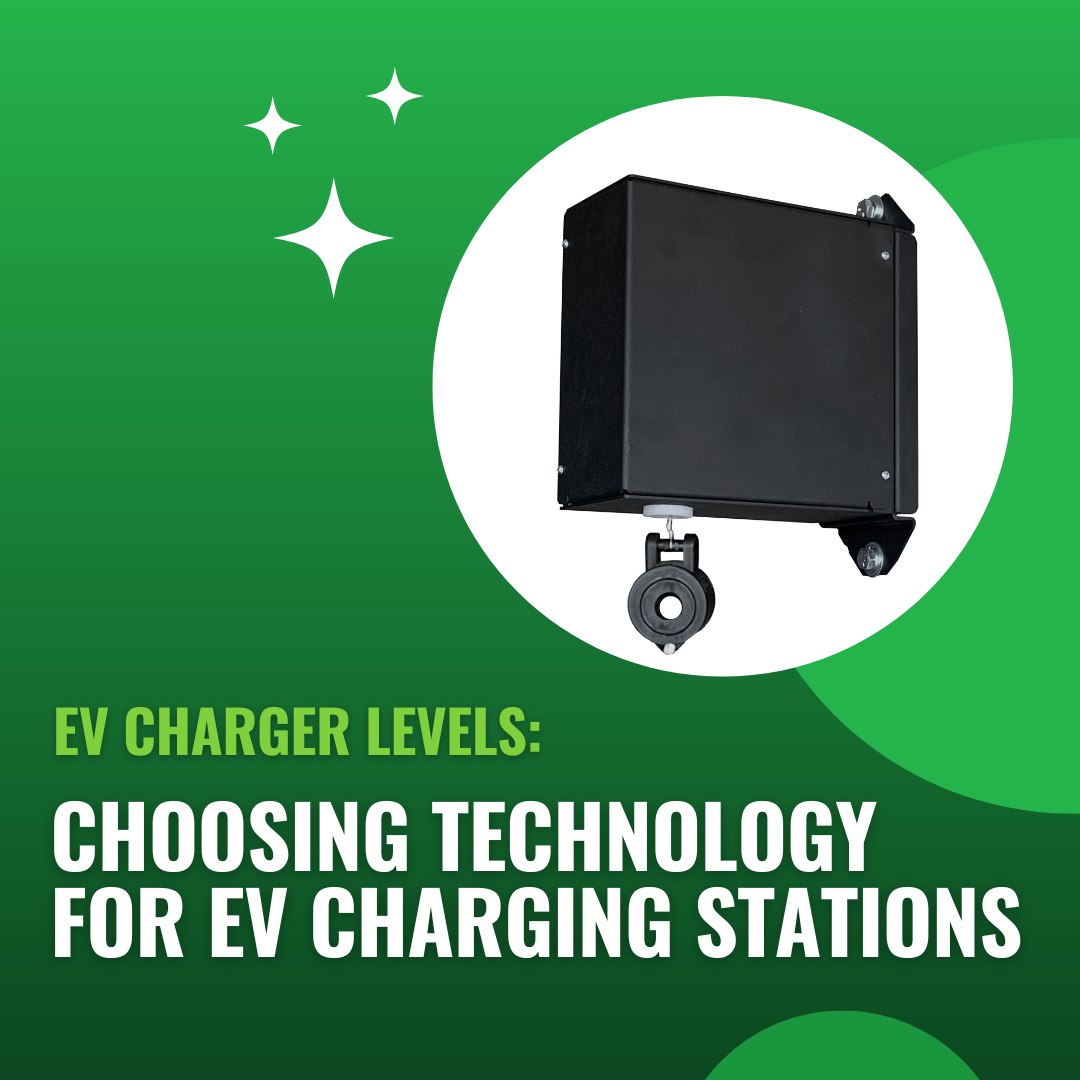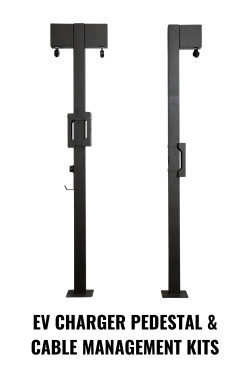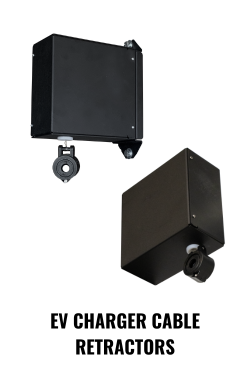We use cookies to make your experience better. To comply with the new e-Privacy directive, we need to ask for your consent to set the cookies. Learn more.
EV Charger Levels: Choosing Technology for EV Charging Stations
By the end of 2022, electric vehicle (EV) drivers could recharge their batteries at about 140,000 charging stations across the U.S. The vast majority of these — 126,500 of them, according to S&P Global Mobility — used a technology called Level 2 EV charging. Less than 14,000 charging stations relied on Level 3 chargers, while the remainder were proprietary Tesla stations.

Regardless of the charging technology, however, that’s not enough charging stations. Projections from S&P Global suggest we’ll need over 1 million Level 2 chargers, and roughly one tenth as many Level 3 chargers, to support the number of EVs on the roads by 2027.
Outside of the private chargers EV owners may employ at home, charging facilities fall into three general categories.
- First, there are public charging stations. These amenities provide EV charging as a service for free.
- Next, there are commercial charging stations. These businesses are analogous to today’s gas stations. They may charge by the hour, the kilowatt-hour, or a fixed fee.
- Finally, there are fleet charging facilities, which keep electric business vehicles (such as delivery trucks) charged for use.
If you plan to operate any of these three types of EV charging stations, you must start by choosing the appropriate technology. That requires an understanding of EV charger levels.
We’ve alluded to two of these already. In this article, we’ll provide an introduction to the three levels of EV charging. Then we’ll discuss which option is best for the three use cases outlined above. Finally, we’ll explore some of the additional infrastructure you’ll need to construct a successful EV charging station.
Here’s a business owner’s guide to EV charger levels.
Explore EV Charger Handling solutions from Solus Group.
EV Charging Levels Explained
Charging levels for both battery-powered EVs and plug-in hybrid EVs (which also use gasoline) are defined by the Society of Automotive Engineers (SAE) in publication J1772. However, charging technology continues to develop while complying with these standards. That makes it hard to provide hard-and-fast information about the capabilities of EV chargers, from one level to the next.
That said, the U.S. Department of Transportation and the Alternative Fuels Data Center provide authoritative guidance on EV charger levels. Here’s how these government sources describe the three standard EV charger levels: Level 1, Level 2, and DC Fast Charge (often referred to as “Level 3” chargers). 
Level 1 EV Charging
Most battery-powered EVs offer the ability to use Level 1 charging. This is the slowest type of EV charger, but it carries a big advantage: It doesn’t require special electric installations. Level 1 charging allows you to simply plug your EV’s charging cable into a standard 120V wall outlet.
For that reason, it’s a common method of charging passenger EVs at home.
- Voltage: 110V or 120V
- Range Addition: Up to 5 miles per charge-hour
- Time to Charge a 60 kWh Battery from 0 to 80 percent: 40 to 50 hours (or more)
- Recommended Applications: Long-term parking: Homes, airports, parking garages, etc.
Level 2 EV Charging
As we mentioned earlier, Level 2 charging is the most common technology for public and commercial EV charging stations. This technology offers a balance between charging speed and the robustness of electrical installations.
Level 2 charging relies on 240V outlets, recognizable for their use in powering residential appliances like clothes dryers or electric ovens. In commercial buildings, 208V outlets are more common; Level 2 charging applies to both.
- Voltage: 208V or 240V
- Range Addition: Up to 25 miles per charge-hour
- Time to Charge a 60 kWh Battery from 0 to 80 percent: 4 to 10 hours
- Recommended Applications: Short-term parking: Fleet depots, workplaces, residential buildings, etc.
DC Fast Charge (or Level 3) EV Charging
The previous two EV charger levels use alternating current, or AC, power, to match the electrical grid. Level 3 chargers convert the grid’s AC power to direct current (DC), which is how energy is stored in the EV battery itself.
Vehicles carry small converters that change AC power to DC prior to storing it in the battery. Level 3 chargers use much larger converters to move more DC power, more quickly, into batteries. These chargers are typically used for the types of charging stations that line highways, much like gas stations. 
- Voltage: 400V to 1000V DC
- Range Addition: Up to 240 miles per charge-hour
- Time to Charge a 60 kWh Battery from 0 to 80 percent: 20 minutes to 1 hour
- Recommended Applications: Commercial charging stations
Next, we’ll discuss how these technologies can be used in EV charging stations for public or commercial applications.
Choosing EV Charger Levels for Public, Commercial, and Fleet-Charging Facilities
We’ve hinted at the appropriate use cases for each of these charger levels, but let’s take a closer look at common use cases. First off, Level 1 charging probably isn’t the right technology for charging stations run by a business. Whether you wish to provide a customer amenity, charge your delivery fleet, or operate an EV charging company, you typically can’t leave vehicles plugged in for one or more days at a time.
That leaves Level 2 and DC Fast Charge equipment. So far, Level 2 is the dominant technology for fleet charging and public usage. Commercial EV charging stations that update the same basic business model as the 20th century gas station are usually best served by DC Fast Charge technology.
Of course, regardless of your business model, EV chargers aren’t the only equipment you need to build an EV charging station. Here are a few additional solutions you’ll need to build an EV charging facility around the most common EV charger level.
EV Charging Infrastructure for Level 2 Charging Stations
Because DC Fast Chargers house sizable power converters, they tend to ship as all-in-one units. Level 2 chargers are different; they’re typically designed to be mounted on walls or stands. If you’re not installing charging stations near walls, Level 2 EV charging stations definitely require some sort of free-standing support.
In addition to these charger stands, EV charging stations must also incorporate means to manage charging cables. Without cable management equipment, charging cables might end up on the ground, where it’s easy for vehicles to run over them, causing expensive damage. Even worse, unmanaged cables create injury risks by creating tripping hazards.
Besides, Article 625 of the National Electrical Code (NEC) requires EV charging stations to include cable management systems for cables over 25 feet (7.5 meters). In short, no EV charging station is complete without a way to keep charger cables safe and tidy.
Learn more: A Fleet Owner’s Guide to NEC Article 625: Electric Vehicle Charging Systems
EV Charger Pedestals and Cable Management Kits from Solus Group provide charger stands and cable solutions in a single unit. These steel posts meet NEC Article 625 requirements for charger height. They also support up to two chargers on a single unit, all within a compact footprint. And they ship with integrated Cable Management Kits, featuring EV cable retractors protected by weather-resistant housings.
These EV charger support systems provide dependable service indoors or out. They protect charging equipment while ensuring convenient access. Whether you plan to build a single public charging station or a whole fleet-charging depot, EV Charger Pedestal and Cable Management Kits are the ideal solution for Level 2 EV chargers — and may be appropriate for other EV charger levels, as well, depending on the equipment.
Or call Solus Group at 314-696-0200 to discuss your next project.
